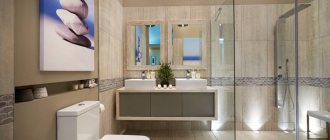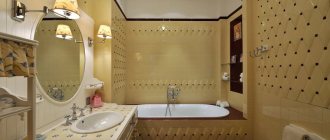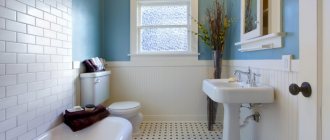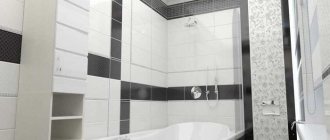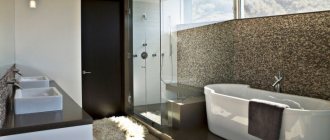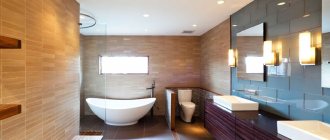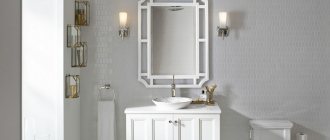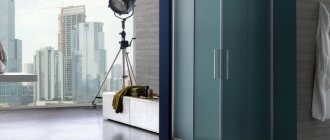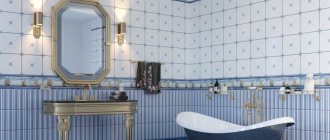Modern options for bathroom borders are striking in their variety: from the most stylish and expensive ones - requiring installation by a qualified specialist, to elementary simple, self-adhesive ones with a budget cost, the installation of which even girls can do.
In order to correctly navigate and choose the appropriate option, you need to familiarize yourself with the characteristics of the currently existing types of borders presented in retail chains.
The border, in addition to its attractive appearance, has numerous advantages.
Why do you need a bathroom border?
The gap that forms between the wall and the bathtub is not only unaesthetic and inconvenient. This is a rather serious problem with all the ensuing consequences: the spread of fungus or mold, which not only spoils the appearance, but also negatively affects health, causing an unpleasant odor and dampness in the room.
To eliminate and disguise unaesthetic gaps, bathroom curbs are used, which are made from special wear-resistant materials, have an attractive appearance and are reliable protection against leaks.
A gap formed between the wall and the bathtub, shower tray or sink can become a serious problem.
What glue to choose for gluing skirting boards
The most commonly used glue is silicone. This composition is susceptible to mold over time. To avoid this, it is recommended to use special disinfectants.
Aquarium glue can be used as an adhesive to avoid the formation of fungus or mold.
Note! Some sealants are unable to provide high-quality adherence to baseboards. As a result, they begin to move away from the walls. To solve the problem, polymer compounds that have the necessary elasticity are used. Glue only the part that is adjacent to the wall.
Why does a leak form between the bathtub and the wall?
The reason for the appearance of cracks and leaks may be a violation of the stages of finishing the bathroom. To avoid this problem, you should follow a certain sequence of bathroom repairs:
- The first stage is leveling and screeding the floor.
- Next is leveling the walls and priming.
- The next stage is tiling the floor.
- Installation of a bathtub bowl.
- Tiling the walls of the room.
This scheme of work allows you to completely eliminate the distance between the bathtub and the wall. As a result of disruption of order, a gap is formed, which, in the presence of curved walls, can reach a width of several centimeters. It is for such cases that the best solution is to use a ceramic or plastic border for the bathroom, which will not only hide the gap, but also become a reliable barrier to water penetration.
Using a border, you can competently and aesthetically seal the resulting joint.
Installation technology for a ceramic bath border
Ceramic borders consist of straight, corner and end elements. The number of straight elements is calculated based on the size of the bathtub/shower tray, corners and ends; standard placement requires two for a bathtub; for a shower tray, there can be one corner. Take the number of straight elements with a small margin - for trimming.
It is advisable to inspect all elements before installation. If there is a need (they are not joined accurately, there are differences in thickness, etc.), the back side can be slightly improved with a file. It is better not to use an angle grinder - the chance of doing more harm than correcting it is too great.
Installation methods
The method of installing a ceramic border depends on the finish of the wall and the size of the gap. If it's tile, you can use waterproof adhesive. If the tiles are embossed or the wall is simply plastered, installation with adhesive does not provide the required level of tightness. In this case, install a ceramic bath border using a special tile adhesive for wet rooms. It is sold in bags in dry form; before use, a certain amount is mixed with water until smooth.
Sequencing
The whole process consists of a sequence of steps:
- The surface is cleaned of deposits and dust. If there is mold, remove it, treat the wall with an antibacterial compound, and let it dry.
- If the gap between the bathtub and the wall exceeds half the width of the existing curb, it must first be sealed. It’s better to make formwork from below and fill it with cement mortar. The second way is to attach moisture-resistant gypsum board in two layers. If the shelf turns out to be large (more than 5 cm), it must be made with a slope. Maybe about 5%. This way you can use the shelf (put something on it) and the water will not stagnate on it. If necessary (if the border does not cover the entire wall), the tiles used to decorate the walls are first laid, and then the installation of the ceramic border for the bathtub continues.
- Start from one of the corners. Set the angle, then two adjacent straight segments. A layer of glue is applied to the back side of the border and leveled. It is installed in place, pressed, and leveled.
- Then continue laying to one side. End elements are installed on the sidewalls.
The process of installing a ceramic border for a bathroom is not much different from laying tiles. The actions are the same. It is necessary to align the elements in two planes - so that both the edges and the plane go smoothly and without differences.
Types of plumbing corners for the bathroom
A bathroom border is a rectangular, even strip 5cm wide and 30-35cm long. It is used for sealing joints between the bathtub and the wall, as well as for other plumbing items.
This corner is made from special materials that are resistant to mechanical stress, temperature changes, and can withstand contact with water and household chemicals.
There are the following types of plumbing corners:
- ceramic skirting board;
- self-leveling acrylic profile for bathtub;
- rubber wall rim;
- silicone side;
- plastic self-adhesive border for tiles;
- flexible tape for shower cabin.
Modern borders are produced in several design variations, they can have all sorts of colors and are made from different raw materials.
Ceramic skirting board
It is considered the most durable and most suitable for the climatic conditions of the bathroom. A ceramic baseboard will provide complete protection against water entering outside the bathtub. They can be made of marble, granite or ceramics.
Products made from mineral raw materials are distinguished not only by high quality, but also by high prices. Therefore, it is advisable to install such a border if the walls and floors of the room are also decorated with marble or ceramics.
This model can be a strip or corner that is mounted using epoxy resin or a moisture-resistant solution.
Self-leveling acrylic profile for bathtub
An acrylic border for waterproofing is much cheaper than a ceramic one, but also reliably protects against water getting into the joint. The main advantages of this model are ease of installation and durability. Acrylic is a safe and environmentally friendly material.
Visually, an acrylic bathtub with an acrylic plinth looks like a single whole, and at the same time, such a plinth is mainly suitable only for acrylic bathtubs.
Rubber wall bead
Available in the form of a flexible rubber strip up to 10 centimeters wide or a soft rubber corner. The profile is very elastic, sold in rolls, made of polyurethane with a high rubber content.
A soft plinth or plinth tape is attached to a special adhesive composition. Most products already have a layer of adhesive applied to them; to install them on a bathtub, just remove the protective film and press it well to the surface.
Flexible plinth is used for finishing non-standard shapes.
Such a product can be held securely for some time, but it is not durable. The main advantage is budget prices.
Silicone rim to prevent water from flowing in
Before installing it, it is necessary to treat the gap with silicone sealant. After it has dried, you can install the self-adhesive corner. To do this, just remove the protective tape and press one part tightly against the wall and the other against the bathroom.
It is characterized by speed and ease of installation, as well as low cost. Not durable.
Plastic self-adhesive border for tiles
The plastic border for the bathtub can be either regular or self-adhesive. Most often they are used in cases of cladding bathroom walls with PVC panels. They can be in the form of a corner or ribbon 3-6cm wide and 1.8-3m long.
There are several types:
- Internal – installed during installation of tiles;
- External - installed after finishing the walls with tiles. Most often they are fixed due to the presence of an adhesive layer located on the inside;
- Composite - consist of two parts: a decorative corner and a fastening element in the form of a strip. This model is installed in several stages. The fastening strip is installed on the wall while laying the tiles. Then the bathtub is installed, and after that the decorative corner is attached.
The products are distinguished by a variety of colors and low prices.
Flexible tape for shower cabin
Flexible border tape with a self-adhesive base is the fastest, most convenient and inexpensive way to eliminate the gap between the bathtub and the tiles. The protective film is removed from the adhesive layer, and the border is pressed tightly against the surface of the wall and the bathtub at the same time.
This tape is mounted on a dry, clean, alcohol-free, dense surface.
It should be noted that this model can hide small gaps and its service life is only 1.5-2 years.
Types of skirting boards by material
Features of the room intended for the bathroom are:
- high degree of humidity;
- poor ventilation;
- the formation of water droplets on any surface.
In such conditions, there is a possibility of rapid spread of fungus and mold. Therefore, the finishing material must be chosen so that it is resistant to all these factors. The same approach should be taken to choosing material for the border in the bathroom.
What types of skirting boards are there for a bath:
- plastic;
- ceramic;
- marble;
- acrylic;
- self-adhesive silicone.
Let us give a detailed description of these products.
Plastic
Plastic is ideal for the bathroom
The most popular is plastic baseboard for the bathroom due to the fact that it is made of practical material that is easy to install and subsequently care for.
It has many types of designs, shapes and structures. It is absolutely resistant to moisture and is able to reliably seal the joint between the wall and the bathroom. This quality is ensured by a special elastic rubber plate on the back of the product.
Related article: Second life of old things
Installation of baseboards in a plastic bathroom is carried out in the following order:
- The plastic product is usually glued to the bathtub and ceramic tiles. The question arises, how to glue the product? It is best to use glue that will set almost instantly. Another requirement for the adhesive composition is its transparency.
- The products are pre-cut in accordance with the dimensions of the sides of the bathroom. For this purpose, you can use a hacksaw with fine teeth. Corner cuts should be made at an angle of 450.
- The edges of the plinth are protected with masking tape to prevent glue from getting on the front surface of the product.
- An adhesive is applied to the back surface of the plinth and laid in place. It is necessary to hold the product pressed to the surface until the glue completely sets.
- After the baseboards are installed along all the sides, we proceed to installing the corners and caps.
- Along the borders where the baseboard meets the wall and the bathroom, we treat it with transparent silicone sealant.
Installation of PVC skirting boards can be done both before and after tiling. But experts recommend the second option to ensure the ability to replace the baseboard if necessary.
Ceramic
Ceramic parts must be protected from impacts
Ceramic baseboard for a bath is a more expensive material. The installation process is also more complicated than a plastic product, but it all pays off in terms of service life. Of course, it is necessary to ensure the safety of the material from impacts, since as a result, cracks may appear on the product.
The ceramic border has a rather rich appearance, is varied in design and has different sizes. It can be selected to match the width of the ceramic tile.
Let's look at how to make a ceramic baseboard in a bathroom:
- We measure the sides of the bathroom and cut the border to the required length;
- it is necessary to install the border using an adhesive mixture for tiles;
- To finish the corners, you need to purchase special corner elements;
- After the adhesive mixture hardens, we treat the seams using a specialized grout. For details of the process, watch this video:
It is better to cut ceramic plinth using a grinder. For this purpose, discs with fine diamond coating are used.
Marble
Marble border is one of the most durable and expensive materials.
Related article: Installation of a partition on a loggia and balcony
It looks quite luxurious and expensive.
Moreover, please note that this type of product is very difficult to match to the bathroom design.
In this case, it is necessary to think through the interior of the bathroom in advance and provide for the presence of any other elements made from this material.
Self-adhesive silicone elements
This type of product is made from polymer materials. Self-adhesive plinth for protecting the bathroom is characterized by fairly simple installation and low price. With its help, you can minimize the size of the joint between the baseboard and the wall or the surface of the bowl. For more information about the sticker, watch this video:
Self-adhesive silicone bathtub borders have to be replaced every 2 years, or even less.
How to glue the baseboard to this type of bathtub? Performing this process is quite simple using the presented diagram:
- From the back side of the tape, a strip is gradually removed, which is intended to protect the adhesive composition, and laid on the surface at a right angle. To ensure the correct angle, use a plastic spatula;
- We arrange the tape in the corners with an overlay.
Acrylic
Acrylic baseboards in the bathroom are best installed on acrylic bowls. It has such characteristics as the absence of deformation and resistance to the effects of aggressive chemical compounds. Installation is carried out according to the algorithm for installing a plastic border. The use of acrylic baseboard will ensure the absence of mold and rot in the bathroom.
What can you use to make a bath rim with your own hands?
The easiest way to make a bathtub rim with your own hands is to use white or transparent sealant and fill the gap between the tiles and the bathtub. It can be used as a temporary one.
This option does not look very aesthetically pleasing and will not last long.
A durable and reliable border can be made from leftover tiles. You just need to try to cut it evenly, otherwise it won’t look very neat. It is better to install a homemade ceramic border using special glue or liquid nails. If you have evenly cut parts of the same color as the entire wall cladding, this option is not only reliable and practical, but also looks very aesthetically pleasing. However, some consider this a thing of the past; now it is no longer in fashion.
What types of bath skirting boards are there?
The types of moldings that can be found in finishing materials stores today can be divided into three types:
- Plastic, one- and two-piece.
- Plastic flexible, tape.
Plastic skirting boards
There are a lot of varieties of one-piece plastic bath skirting boards, and the photo below shows the most popular of them. This model is very easy to install, using liquid nails or silicone glue. , like floor and ceiling moldings, or special fittings are used. Plastic will last quite a long time, but it cannot be cleaned with abrasive agents, in addition, the material does not tolerate exposure to aggressive chemicals.
One-piece skirting board for acrylic or metal bathtub
The next bath skirting board, plastic, is installed simultaneously with the wall tiles. One edge of this molding rests on the side, and the other goes under the tile, embedded in the tile adhesive. A bathtub plinth on tiles is usually used in cases where the dimensions of the bathtub are large relative to the room, and the wall covering cannot be placed down the wall.
Installing plastic molding with one edge under the tile
Next is a two-piece bathtub plinth. In essence, it is the same as plastic molding for countertops: first, a mounting rail is installed, onto which the outer part is then attached. This baguette has the same disadvantages as described above for one-piece profiles.
Two-piece plinth
Tape skirting boards for bathtubs are sold in the form of self-adhesive tape, hence the name of the material. This molding is best used as a temporary way to seal the seams between the bathtub and the wall. Self-adhesive bath skirting board is a rather capricious material. The apparent simplicity of installation actually turns into serious preliminary cleaning of surfaces. Without appropriate preparation of the working area, the tape will periodically peel off during operation.
Strip plinth
Description and installation of ceramic molding
Ceramic skirting boards will cost more than any plastic ones, but the expense will be completely justified. Ceramics will last much longer and will not change color over time or exposure to chemicals. In addition, the surface of these moldings is more difficult to scratch.
The color palette of ceramic baguettes is quite small; in fact, the photo below shows almost all the colors that you can find in stores. The joining of moldings in the corners is carried out by trimming, as for floor or ceiling baguettes, or corner elements are used, as in the photo.
Ceramic baseboard for bath. Photo of several elements in different colors
Before laying the ceramic baseboard on the bathtub, all gaps must be carefully sealed. If the cracks are larger than 0.5 cm, then we first foam them, having previously protected the adjacent surfaces with masking tape. After the foam has dried, carefully trim off the excess material with a knife. For gaps up to 0.5 cm, this step can be skipped.
In the following video you can see how to glue the baseboard to the bathtub:
Further. If the masking tape on the walls remains intact, then we leave it as is, and if it is damaged, then we remove it and stick on a fresh piece. Now we take a silicone-based sealant and coat the entire seam. Immediately remove the excess with a special plastic spatula. We wait for the glue to dry completely.
How to install ceramic moldings: pre-treat the seam with silicone or acrylic sealant
Now the actual installation of the baseboard between the bathroom and the wall. It is better not to use silicone-based adhesives here, as they can turn black during use. Liquid Nails glue, marked MB50 or MB70, works well. It is applied to the entire back surface of the molding, then it is pressed and held for several seconds.
Then you can begin installing the following elements around the bathtub. Finally, we close the side sections of the plinths with special end caps, as in the photo. We coat the seams with acrylic-based sealant. Installation of skirting boards is completed.
When cutting ceramic moldings, it is better to use a grinder with a solid diamond blade. This is the only way to ensure an even cut on the ceramic, and the glaze will remain intact. But using a fragmented disk can lead to chipping of the edges and damage to the glaze.
Installation of end caps
What dimensions can a tiled molding for a bath have?
Modern ceramic modules can become a designer find in the overall style of the bathroom. They are distinguished by a wide choice of patterns, colors and decor. There are three main types:
- pencil - a thin strip designed for narrow and long crevices;
- corner - the most common type, designed for sealing medium-sized joints;
- frieze - a variant of a corner and tiles in the form of an influx.
The size of pencil borders is usually 15mm in width and 20cm in length. Dimensions of a standard tiled baguette: 5.5 cm - height and depth, length - 20 cm.
The baguette can come with a set of facing tiles.
How to cut decorative edging around the perimeter of a bathtub
Quite often, when trying on bathroom surrounds, parts have to be trimmed both around the perimeter of the bathroom and in the corners. So, for example, flexible and elastic edgings can be cut with a special construction knife. A sharp construction knife is also quite suitable for cutting plastic or silicone.
However, for options made of ceramics or porcelain stoneware, you will need a special ceramic cutter or a grinder with a diamond blade.
For correct and precise cutting in corners, a special tool is used - a miter box, which allows you to accurately cut even workpieces at an angle of 45 degrees.
Different cutting corners require different tools to be used.
Technology for installing skirting boards at the junction of tiles and bathtubs
Let's take a closer look at the options for laying skirting boards for tiles in a bathroom made of plastic and ceramics.
Installing a PVC border on tiles with your own hands
Installing a plastic border is quite simple, using the instructions:
- Wipe the edges of the tiles and edges adjacent to the joints with a dry cloth.
- Seal the gap with sealant and wait until it dries completely.
- Cut the plastic profile into pieces equal to the lengths of the sides of the bathtub. Cut their edges at an angle of 45°.
- To protect against contamination with glue, apply masking tape at a distance of 2 mm from the intended installation location of the corner, as well as on the corner itself.
- Glue the corner between the bathtub and the tiles. Why apply it to the corner and press with force. At this time, bend the top side of the curb outward and apply sealant under it using a special gun. Level the layer of sealant with a spatula. Do the same with the bottom edge of the corner.
Applying sealant under plastic baseboards
The border gluing stage requires the participation of a partner. Since alone it is not possible to press the corner to the surface with equal quality and force and at the same time fill the space under it with sealant.
Installation of a ceramic plinth at the junction with a bathtub under tiles
Installing a ceramic border is a little more complicated. The process technology is as follows:
- Remove dirt and grease, wipe dry the surface around the perimeter of the bathroom and along the wall.
- Carefully seal the gap between the wall and the bathtub with sealant using a special gun. Level the layer of sealant with a spatula or fingers soaked in water.
When applying sealant with your fingers, you can use tape to level it
- Dilute the tile adhesive in water to the required thick consistency.
- Cut the edges of the ceramic skirting boards at 45° using a diamond grinder disc or pliers, breaking off a piece along a pre-drawn line.
Ceramic border is usually sold together with corner elements
- Smooth the cut edges with a polishing stone.
- Apply glue to the underside of the border with a spatula. Glue the ceramic bathroom corner under the tile, pressing it firmly against the curb.
For better adhesion of the glue to the surfaces, it is recommended to fill the installed borders with water the next day after it has dried.
When choosing plastic or ceramic options for corners, it is necessary to take into account that for the first option, experts guarantee preservation of tightness for a period of no more than a year with the need for subsequent replacement, while ceramics, if handled with care, will last for decades without deterioration in performance properties.
How to glue molding to a bathtub
Most often, craftsmen advise laying moldings using sealants with silicone. However, any sealant darkens from water and after a couple of years lags behind the wall. For these purposes, it is necessary to use sealants intended for aquariums. Thanks to special additives, they do not darken and are not susceptible to fungus and mold. Especially if the composition includes MS polymers (Moment, Crystal).
It is better to use white or transparent ones with high hydro-repellent properties.
The ceramic border can be glued using epoxy resin or a special moisture-resistant solution.
If there is no sealant, liquid nails or tile adhesive will do. The plinth can only be installed on a dry, clean and grease-free surface.
Features and types of corners
Attaching the outer corners can be done with liquid nails or silicone glue. In this case, we trim the joints or use ready-made corners.
the corners with an internal direction on the side of the bathtub, and place the other end under the tile.
two-part corners with self-tapping screws or silicone. The plinth snaps into place at the top.
Moldings are used to hide defects. Large ones are mounted only in large rooms. For small bathtubs, purchase wide borders. And if you have low ceilings, then vertical elements will look good.
Skirting boards for external cladding do not allow water to pass under the bathroom and add aesthetic notes.
Installing a border in the form of a corner
To install any type of plastic bathtub sides you will need the following tools:
- roulette, level;
- miter box – a tool for making oblique cuts;
- rubber and plastic spatula;
- masking tape;
- construction knife;
- sealant, acetone, liquid nails;
- construction pistol.
Before the installation procedure, it is necessary to clean, degrease and dry the surface on which the corner will be mounted. Next, you need to use a construction gun to fill all the cracks with sealant. While the sealant is drying, you can stick masking tape on the tiles and the bathtub around the entire perimeter - this will protect them from getting glue.
The plastic corner itself must be cut into the required number of pieces of appropriate sizes.
Then you need to apply glue to the inside of the corner, preferably evenly distributing it over the entire surface. Next, the corner is installed on the bathtub and pressed until adhesion occurs. In the corners of the bathroom, the border is cut at an angle of 45 degrees, and special caps are attached to the ends for a pleasant appearance and completeness of the canvas. After a day, you can use the bathroom and not be afraid of leaks.
After the glue has dried, you can proceed to the final stage - covering the joints of the corner border with a transparent sealant.
Some secrets for installing baseboards in the bathroom
Before starting work, we cover the bathroom; you can simply cover it with oilcloth or cardboard.
If the bathroom originally had caulking or baseboards, then we dismantle them.
We thoroughly clean all gaps and fungus. We degrease the surface; you can use alcohol for this purpose.
We dry everything with a hairdryer.
We measure and cut the profile. We cut the corners for a 45-degree cut or buy specially made ones in the store. We make sure to check whether our parts match the dimensions and how tightly they will fit.
If there are water pipes in the path of the baseboard, cut holes for them.
There are three options for correct installation:
If the gap is up to 0.3 cm, fill it with silicone, and after it dries, install the baseboard.- A gap of up to 2.5 cm can be immediately closed with a plinth. But choose so that the width of the plinth should be 3 times larger than the crack itself.
- Cracks larger than 3 cm are first filled with an epoxy mixture solution. This procedure requires a small formwork. We install the plinth only after drying.
When installing, maintain an angle of 45 degrees, as this position will ensure the best drainage of water.
Classification
Plinth for walls - perfectly repels moisture and is not afraid of detergents. Most often in the bathroom you can find plastic, a little less often ceramic baseboard or self-adhesive tape.
Polyurethane or foam baseboards are used for ceilings. The first skirting boards are flexible and durable, and are also not picky about types of glue. The second ones are fragile, but during installation they are easier to work with.
For the floor, choose ceramic or PVC skirting boards. They are durable and unpretentious.
Ceramic baseboard
If the gap between the bathtub and the wall is more than 2.5 cm, and other building materials are powerless, take a ceramic baseboard.
- It is resistant to household products and cleaning products.
- Not susceptible to putrefactive deposits.
- Remains in its original form for a long time, without any deformation.
- It has a large number of colors, shapes and textures.
- Service life more than 10-15 years.
The main disadvantages include the high price. Installation is best left to a specialist. If damaged or chipped, mold and fungal deposits may appear.
For installation, be sure to prepare sealant and tile adhesive, and also take tiles with a reserve (+2).
Ceramic products can be mounted in different ways: on top of tiles, between floor and wall tiles.
Before installation, thoroughly clean the baseboard and edges of the bathroom. We coat all gaps with sealant. If there are voids, they must be filled. When the sealant has hardened, prepare the tile adhesive as indicated in the instructions. We apply it to the rough side and place it in the right place. Make sure that there are no gaps and that the baseboard fits tightly to the wall and the bathroom. Leave it for a day. Fill both edges of the baseboard with sealant and seal.
Plastic plinth
Unlike ceramics, it is much easier to attach, but does not look as solid.
For a tighter fit, many models have seals.
Most often they take the white option, but it may turn yellow over time, so you can consider colored options.
Self-adhesive tape
Ideal for filling gaps of 5-15 mm. Installing this tape will take you no more than 5 minutes.
An inexpensive option, yet quite durable and flexible. Service life is about 2-3 years.
The strength of the fastening depends on the material on the walls and the bathroom.
Before starting work, we clean the surface. We fill all the cracks with silicone.
During installation, peel off the impregnation to a maximum of 15 cm. Squeeze out small bubbles and press the tape tightly, without tension.
When we reach the corner, we easily bend the tape and work further. When finished, trim the edge and apply sealant. We cut off the corner fold and cover it with silicone.
After 24 hours you can use the bathroom.
PVC elements
Before starting work, we degrease the surface. We measure the required size and saw off at an angle of 45.
Apply sealant over the entire surface and onto the baseboard. We install the corners; if they are not there, then cover the joints with silicone.
If you are attaching the baseboard with liquid nails or glue, be sure to read the instructions. These solutions dry quickly, so you need to work faster. Hold it a little until the material sets. Don’t forget to coat all joints with sealant.
Plastic structures are easy to install using self-tapping screws. We start installation from the corners, using special parts.
If wiring is required, take care of waterproofing.
How to paint a ceramic border
The thought of painting ceramics can make most people confused. However, in order not to remove the old, but quite securely sitting border, you can simply update or refresh it.
Before painting, the border must be washed thoroughly, especially the seams. After drying, a layer of primer with high adhesion is applied to it.
After the primer has dried, you can begin painting. For this purpose, it is better to use epoxy or acrylic compounds.
Coverings painted with satin enamel look gorgeous. It gives items a unique velvety effect.
It is very important to choose paints labeled “for wet areas.”
It is advisable to apply several layers of paint for saturation and stability. If desired, you can make a stencil with a pattern or ornament from cardboard and apply the pattern through the stencil using a soft sponge. After drying, the paint is coated with two layers of varnish. It is better to choose water-based varnishes.
This option for updating the baseboard finish deserves attention due to its simplicity, ease, speed and low cost.
Which bathroom border is better to choose?
In order not to make a mistake when choosing a border for the bathroom, you need to consider some points:
- What material does the main finishing of the walls and floor of the room consist of? For example, a ceramic plinth is ideal for marble or ceramic coatings. For a bathroom decorated with plastic panels, a plastic, silicone or acrylic border would be appropriate.
- You need to pay attention to the width of the gap and the evenness of the walls and the bath itself. The larger the gap, the wider the baseboard is needed. If the joint is more than 2-3 cm, it is filled with a moisture-resistant solution. Only after it has dried can the border be installed.
- If the bathroom is of a non-standard shape, it is better to choose more elastic and flexible models of sides.
- The color can be chosen to match the walls or the bath itself.
- Whatever the border, the main attention when choosing should be paid to its quality.
A decorative border made of ceramics allows you to add a certain chic, sophistication and originality to your bathroom design.
Features of choosing a baseboard for a bathroom
It is necessary to take care of sealing the bathroom. This room in particular suffers from high humidity. The formation of fungus and other unfavorable phenomena is possible if special treatment agents are not used. Baguette allows you to solve most of these shortcomings.
Make your choice consciously, which will allow you to avoid unreasonable costs.
The process of selecting and purchasing skirting boards is quite complex and takes time. You should pay attention to the following parameters:
- Price. There are many different models that differ in price category. There are cheap solutions that last for several years. If you need something more durable, then it is better to pay attention to marble or ceramic elements. They are distinguished by their attractive appearance, ease of maintenance and long service life.
- Decorative function. There are materials that complement the coating and are practically no different from it. If you want to decorate the room, you can use various decorative elements.
- Material. For the border, you should use the same material that was used for the main coating of the bathtub or tiles. It looks beautiful, does not catch the eye, and also speaks of the good taste of the owner. This decision is yours.
- Gap. One of those parameters that speaks in favor of a particular material. Consider the width of the baguette to carefully seal the gap.
If the bathroom skirting board is of high quality, all its functions will be maintained throughout the life of the border.
Important! Select the material in accordance with the operating requirements of the room. The main thing is that you like the end result.
When you seal the joints, you will need to use plugs. They eliminate unnecessary gaps in the design. To arrange corners, corner elements are used, which make it easier to join elements.
The border must be 100% waterproof to reliably protect the joint from mold, rot, moisture and mildew.
Where to buy a quality bath corner
Currently, the corner can be purchased at construction markets, in huge construction stores and, of course, in online stores.
In an online store there is no opportunity to take a good look at the product in order to determine the quality and make sure that the desired pattern or shade is correct. In construction markets, goods are often stored in incorrect conditions, which can subsequently affect the quality and service life. This is especially true for self-adhesive models, which must be stored in dry and warm rooms. It turns out that large hardware stores are most convenient in this regard. Here you can view the product, check the quality, consult with a specialist and purchase additional items if necessary. The storage conditions for the goods are decent and the goods can be changed if necessary. Most importantly, you don’t have to wait days and weeks for the goods to be delivered.
Polymer materials are used to produce self-adhesive curb tape.
Choosing the right baseboard
Choose easy-to-install material
Related article: Did the cat damage the suspended ceiling?
To determine the quality and material from which the baseboard for the bathroom is made, we present several characteristics that this element of the interior should have.
- to reliably protect the bathroom walls from the appearance of fungus, mold and rot, the baseboard must have a 100% degree of moisture resistance;
- It is better to choose a material that is not susceptible to rotting and corrosion;
- If you purchase a plastic skirting board, it must be resistant to household chemicals.
We pay attention to the resistance of products to deformation. It is better to choose a border with a simple installation technology, especially if you plan to install it yourself.
To preserve the original appearance of the plinth for a long time, it is necessary to choose a type of product that will be quite easy to care for. We pay attention to the design. It should be combined with the chosen bathroom interior.
It is not recommended to purchase a white plastic skirting board, as over time it will become yellowish.
Popular manufacturers of anti-wicking skirting boards
Today, popular manufacturers of skirting boards include both foreign and domestic brands and companies.
Leroy Merlin
Leroy Merlin is a famous French hypermarket chain that sells building materials and goods for home and garden. There is a wide selection of finishing materials, including all kinds of baseboard options for the bathroom.
Favorable prices and the possibility of delivery make the purchase even more enjoyable and profitable.
BNV
In 2021, the BNV online store took a leading position in the bathroom border market. The quality of the product was appreciated by customers, and high sales growth rates indicate the popularity of the company. The production is equipped with modern equipment and creates universal acrylic borders for the bathroom. There are 16 models available in different sizes and designs. A convenient way to receive it in any corner of Russia.
Borders and moldings are made to order according to individual sizes.
Mac
Polskaya is a leading global brand in the production and sale of innovative plastic profiles. Products are supplied to the markets of Europe, Asia and the USA. Their products are quick to install, do not absorb moisture, and do not contain lead.
Among the manufactured products there are self-adhesive skirting boards and tapes.
Porcelanosa Group
Porcelanosa Grupo ranks third in the ranking of the best manufacturers of sanitary ware, cladding materials, accessories for spas and hydromassage, as well as furniture. The company employs the best designers who implement the latest technologies in the creation of environmentally friendly materials used for ceramics, plumbing, and furniture. They offer non-standard solutions for the construction of modern buildings.
Today, the concern unites several companies that are engaged in production with a wide range of products. The goods they produce are aimed at creating a comfortable life for people.
The use of modern technologies, concern for the environment and high quality have helped the concern become a leader in the global market.
Such a wide selection of solutions for bathroom design will help the owner of any bathroom to choose options that suit his situation, taste and financial capabilities.
